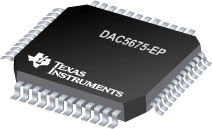

DAC5675-EP是TI公司的一款高速DAC(>10MSPS)产品,DAC5675-EP是增强型产品 14 位 400Msps 数模转换器,本页介绍了DAC5675-EP的产品说明、应用、特性等,并给出了与DAC5675-EP相关的TI元器件型号供参考。
DAC5675-EP - 增强型产品 14 位 400Msps 数模转换器 - 高速DAC(>10MSPS) - 数模转换器 - TI公司(Texas Instruments,德州仪器)
- 400-MSPS Update Rate
- Controlled Baseline
- One Assembly
- One Test Site
- One Fabrication Site
- Extended Temperature Performance of -55°C to 125°C
- Enhanced Diminishing Manufacturing Sources (DMS) Support
- Enhanced Product-Change Notification
- LVDS-Compatible Input Interface
- Spurious-Free Dynamic Range (SFDR) to Nyquist
- 69 dBc at 70 MHz IF, 400 MSPS
- W-CDMA Adjacent Channel Power Ratio (ACPR)
- 73 dBc at 30.72-MHz IF, 122.88 MSPS
- 71 dBc at 61.44-MHz IF, 245.76 MSPS
- Differential Scalable Current Outputs: 2 mA to 20 mA
- On-Chip 1.2-V Reference
- Single 3.3-V Supply Operation
- Power Dissipation: 660 mW at fCLK = 400 MSPS, fOUT = 20 MHz
- Package: 48-Pin PowerPAD Thermally-Enhanced Thin Quad Flat Pack (HTQFP) TJA = 29.1°C/W
- APPLICATIONS
- Cellular Base Transceiver Station Transmit Channel:
- CDMA: WCDMA, CDMA2000, IS-95
- TDMA: GSM, IS-136, EDGE/GPRS
- Supports Single-Carrier and Multicarrier Applications
- Test and Measurement: Arbitrary Waveform Generation
- Military Communications
- Cellular Base Transceiver Station Transmit Channel:
PowerPAD is a trademark of Texas Instruments.
DESCRIPTION/ORDERING INFORMATION
The DAC5675 is a 14-bit resolution high-speed digital-to-analog converter (DAC). The DAC5675 is designed for high-speed digital data transmission in wired and wireless communication systems, high-frequency direct-digital synthesis (DDS), and waveform reconstruction in test and measurement applications. The DAC5675 has excellent spurious-free dynamic range (SFDR) at high intermediate frequencies, which makes it well-suited for multicarrier transmission in TDMA- and CDMA-based cellular base transceiver stations (BTSs).
The DAC5675 operates from a single-supply voltage of 3.3 V. Power dissipation is 660 mW at fCLK = 400 MSPS, fOUT = 70 MHz. The DAC5675 provides a nominal full-scale differential current output of 20 mA, supporting both single-ended and differential applications. The output current can be directly fed to the load with no additional external output buffer required. The output is referred to the analog supply voltage AVDD.
The DAC5675 comprises a low-voltage differential signaling (LVDS) interface for high-speed digital data input. LVDS features a low differential voltage swing with a low constant power consumption across frequency, allowing for high-speed data transmission with low noise levels; that is, with low electromagnetic interference (EMI). LVDS is typically implemented in low-voltage digital CMOS processes, making it the ideal technology for high-speed interfacing between the DAC5675 and high-speed low-voltage CMOS ASICs or FPGAs. The DAC5675 current-source-array architecture supports update rates of up to 400 MSPS. On-chip edge-triggered input latches provide for minimum setup and hold times, thereby relaxing interface timing.
The DAC5675 has been specifically designed for a differential transformer-coupled output with a 50- doubly-terminated load. With the 20-mA full-scale output current, both a 4:1 impedance ratio (resulting in an output power of 4 dBm) and 1:1 impedance ratio transformer (-2 dBm) is supported. The last configuration is preferred for optimum performance at high output frequencies and update rates. The outputs are terminated to AVDD and have voltage compliance ranges from AVDD - 1 to AVDD + 0.3 V.
An accurate on-chip 1.2-V temperature-compensated bandgap reference and control amplifier allows the user to adjust this output current from 20 mA down to 2 mA. This provides 20-dB gain range control capabilities. Alternatively, an external reference voltage may be applied. The DAC5675 features a SLEEP mode, which reduces the standby power to approximately 18 mW.
The DAC5675 is available in a 48-pin PowerPAD™ thermally-enhanced thin quad flat pack (HTQFP). This package increases thermal efficiency in a standard size IC package. The device is specified for operation over the military temperature range of -55°C to 125°C.







